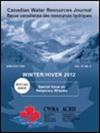Technical guidelines for future intensity–duration–frequency curve estimation in Canada
IF 0.9
4区 环境科学与生态学
Q3 WATER RESOURCES
引用次数: 4
Abstract
ABSTRACT Intensity–duration–frequency (IDF) curves need to be reliable to serve as a relevant tool in preventing or reducing potential damage to society. This often requires accounting for the effect of climate change due to evidence of its effect on extreme precipitation. There is a large number of approaches for IDF curve estimation under climate change in the literature; however, a general framework with practical guidelines for facilitating their application by practitioners is not readily available. The aim of the present study is to provide practical guidelines and recommendations for helping federal and provincial agencies, as well as others who might produce practice guidelines, to develop standardized procedures for the estimation of future IDF curves in Canada that can then be used by practitioners in infrastructure design, management and risk assessment. This is done by gathering and summarizing findings in rainfall frequency analysis from the Canadian FloodNet Research Group, under a practically oriented perspective. Technical recommendations are presented within a methodological framework to facilitate understanding; decision-making procedure-specific flowcharts are provided to facilitate their application. The proposed methodological framework is based on the use of pooled frequency analysis for reasonable estimation of extreme rainfall intensities, and on the estimation of gridded relative changes for IDF updates under climate change following different approaches depending on rain gauge network density. In particular, three methods that do not compete against each other but rather are different methodologies to be applied depending on the case study are proposed: pooled estimation of extreme rainfall in Canada (Method I), gridded relative changes in 24-h extreme rainfall intensities in Canada (Method II) and gridded relative changes in 24-h and sub-daily extreme rainfall intensities in regions of Canada with a relatively high station density (Method III).加拿大未来强度-持续时间-频率曲线估计技术指南
强度-持续时间-频率(IDF)曲线需要可靠,才能作为预防或减少对社会潜在损害的相关工具。这通常需要考虑气候变化的影响,因为有证据表明气候变化对极端降水的影响。文献中关于气候变化条件下IDF曲线估计的方法较多;然而,一个通用的框架和实用的指导方针,以促进他们的应用的实践者是不容易得到的。本研究的目的是提供实用的指导方针和建议,以帮助联邦和省级机构以及其他可能制定实践指导方针的机构制定标准程序,以估计加拿大未来的IDF曲线,然后可供从业人员用于基础设施设计、管理和风险评估。这是通过收集和总结来自加拿大洪水网研究小组的降雨频率分析结果,以实际为导向的角度来完成的。在方法框架内提出技术建议,以促进理解;提供了具体的决策程序流程图,以方便其应用。建议的方法框架是基于使用混合频率分析来合理估计极端降雨强度,以及基于气候变化下IDF更新的网格化相对变化,根据雨量计网络密度采用不同的方法。特别是,提出了三种不相互竞争的方法,而是根据案例研究采用不同的方法:加拿大极端降雨的汇总估计(方法一),加拿大24小时极端降雨强度的网格化相对变化(方法二),以及加拿大站点密度相对较高地区24小时和次日极端降雨强度的网格化相对变化(方法三)。
本文章由计算机程序翻译,如有差异,请以英文原文为准。
求助全文
约1分钟内获得全文
求助全文
来源期刊

Canadian Water Resources Journal
WATER RESOURCES-
CiteScore
2.90
自引率
5.90%
发文量
17
审稿时长
>12 weeks
期刊介绍:
The Canadian Water Resources Journal accepts manuscripts in English or French and publishes abstracts in both official languages. Preference is given to manuscripts focusing on science and policy aspects of Canadian water management. Specifically, manuscripts should stimulate public awareness and understanding of Canada''s water resources, encourage recognition of the high priority of water as a resource, and provide new or increased knowledge on some aspect of Canada''s water.
The Canadian Water Resources Journal was first published in the fall of 1976 and it has grown in stature to be recognized as a quality and important publication in the water resources field.
 求助内容:
求助内容: 应助结果提醒方式:
应助结果提醒方式:


